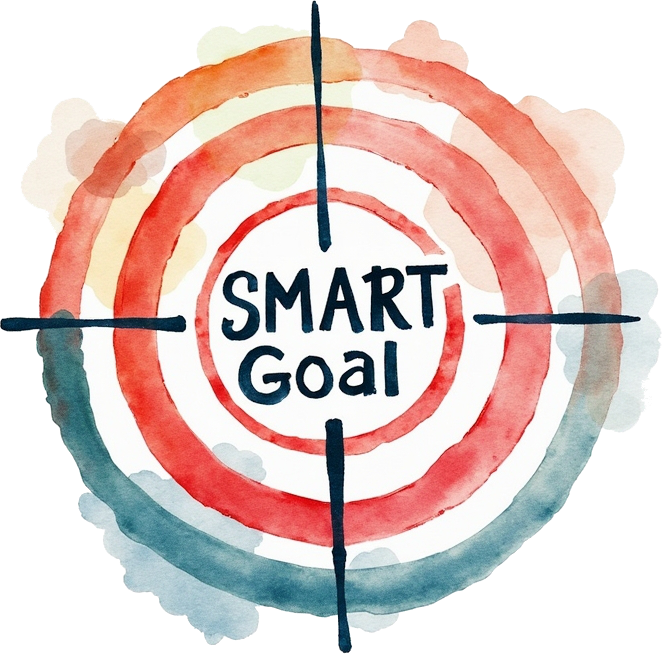
A few years ago, I had a bright A2 student named Mia who loved English but felt “stuck.” She’d been studying for over a year but couldn’t see her progress.
During one lesson, she said, “Teacher, will I ever sound fluent?”
That moment changed how I approached short-term ESL goal-setting forever.
Effective language learning isn’t just about following a curriculum—it’s about giving students a clear path they can see and celebrate. That’s why at Florentis Learning, we don’t stop at placement tests. We help teachers turn results into small, meaningful goals that build momentum and motivation.
Effective language learning isn’t just about following a curriculum—it’s about setting and achieving meaningful goals that motivate students and provide a clear path to progress. For ESL teachers, understanding how to set appropriate short-term goals can make the difference between student frustration and success.
When a student completes a placement test that identifies their CEFR level, such as the one available for free from Florentis Learning (ranging from Pre-A1 to B2), this information provides valuable insight into their current abilities. However, the real challenge lies in transforming this assessment data into actionable, achievable short-term ESL goals that build toward long-term language proficiency.
Short-term goals serve as stepping stones on the journey to language mastery. They provide students with immediate targets to focus on, create opportunities for regular success experiences, and help maintain motivation when long-term objectives seem distant or overwhelming.
✅ New! Need help creating effective, individualized learning plans? Try our free Learning Plan Template Generator (available when you sign up for our free placement assessment). It’s designed to help you quickly set clear, achievable goals for every student.
Understanding Assessment Results
Before setting goals, it’s essential to fully understand what your student’s placement test results mean. Each CEFR level represents a specific set of language capabilities:
| CEFR Level | Florentis Learning Level | General Capabilities |
|---|---|---|
| Pre-A1 – Beginner | Level 1 – Level 2 | Can understand and use basic phrases, introduce themselves, and ask/answer simple questions |
| A1 – Elementary | Level 2 – 3 | Can interact in a simple way, describe where they live, and communicate about familiar topics |
| A2 – Pre-Intermediate | Level 4 – 5 | Can understand frequently used expressions and communicate in routine tasks |
| B1 – Intermediate | Level 5 – 6 | Can deal with most situations while traveling, describe experiences, and briefly explain opinions |
| B2 – Upper Intermediate | Level 6 | Can interact with a degree of fluency, understand complex texts, and produce clear, detailed content |
When I first began using placement results with my students, I realized how easy it was to overwhelm them with long-term goals.
What changed everything was breaking those results down into micro-goals—tiny, specific wins students could achieve every week. That approach became the foundation for how we built the Florentis Learning Placement Assessment and Learning Plan Generator—tools that help you translate test data into daily confidence boosts.
The Florentis Learning placement test provides not just an overall level but will give you a good understanding of strengths and weaknesses across different skill areas (reading, writing, listening, speaking, vocabulary, and grammar) based upon the questions that were challenging for the student. Take notes while administering the assessment that you can refer back to when goal-setting. This granular information is invaluable for setting targeted short-term goals.
Free ESL Goal-Setting Toolkit 🌿
Save time and stay organized with the Florentis Learning Placement & Learning Plan Generator. Assess, plan, and track student progress — all in one simple tool.
🌿 Try It FreeExternal resources for assessment interpretation:
- CEFR Companion Volume – Provides detailed descriptions of each proficiency level
- British Council’s CEFR Level Descriptors – Practical explanations of capabilities at each level
Short-Term vs. Long-Term Goals in ESL Learning
Understanding the relationship between short-term and long-term goals is crucial for effective language teaching:
| Goal Type | Time Frame | Characteristics | Benefits |
|---|---|---|---|
| Short-term ESL goals | Days to weeks | Specific, immediately achievable, focused on discrete skills | Provides regular success experiences, maintains motivation, builds confidence |
| Long-term ESL goals | Months to years | Broader, focuses on overall proficiency, often tied to certification or life goals | Gives direction to learning, connects language skills to real-world applications |
While long-term goals might include “Achieve B2 proficiency” or “Pass the IELTS exam with a score of 7.0,” short-term goals are much more specific: “Master present perfect tense in conversation by next week” or “Successfully order food in a restaurant using appropriate vocabulary and phrases.”
Research from educational psychology shows that breaking larger goals into smaller, achievable steps significantly increases student persistence and success rates. For language learners, this approach is particularly effective because it provides regular opportunities to experience success, reinforcing their belief that they can master the target language.
External resources on goal-setting:
- ELT Journal article: “Goal-setting in language education” – Research-based approaches to goal-setting for language learners
- Cambridge English: Setting Goals for Language Learning – Practical guidance for establishing achievable language learning goals
Setting Level-Specific Short-Term Goals
Based on your student’s current CEFR level, here are appropriate short-term goals that can typically be achieved within 2-4 weeks of regular study:
Pre-A1 Level Short-Term Goals
| Skill Area | Short-Term Goal Examples |
|---|---|
| Vocabulary | Learn and correctly use 20 new food-related words |
| Speaking | Introduce oneself and ask basic personal questions |
| Listening | Recognize and respond to classroom instructions |
| Reading | Match simple words to corresponding pictures |
| Writing | Write basic personal information (name, age, country) |
| Grammar | Use “to be” verbs correctly in simple present tense sentences |
I love giving my A1 students a “Family Challenge” goal: write five sentences about their family using my, your, and their. It’s short, achievable, and students love showing their finished paragraph on camera. This kind of micro-goal builds early writing confidence—and it’s exactly the kind of task built into our Level 2–3 lessons at Florentis Learning.
A1 Level Short-Term Goals
| Skill Area | Short-Term Goal Examples |
|---|---|
| Vocabulary | Master vocabulary for daily routines and tell time |
| Speaking | Describe daily activities using simple present tense |
| Listening | Understand simple directions and follow a basic map |
| Reading | Read and comprehend a short, simplified story |
| Writing | Write 5-7 connected sentences about family or home |
| Grammar | Correctly use basic prepositions of place (in, on, under, next to) |
A2 Level Short-Term Goals
| Skill Area | Short-Term Goal Examples |
|---|---|
| Vocabulary | Use shopping and money-related vocabulary in role plays |
| Speaking | Give a 1-minute description of an experience using past tense |
| Listening | Understand the main points of a short audio conversation |
| Reading | Extract specific information from simple advertisements or notices |
| Writing | Write an informal email to a friend describing weekend plans |
| Grammar | Use present continuous correctly for future arrangements |
B1 Level Short-Term Goals
| Skill Area | Short-Term Goal Examples |
|---|---|
| Vocabulary | Learn and use 15 new phrasal verbs in appropriate contexts |
| Speaking | Express and justify opinions on familiar topics for 2-3 minutes |
| Listening | Summarize the main points of a podcast or radio segment |
| Reading | Identify main arguments in a newspaper article |
| Writing | Write a coherent paragraph comparing two items/places/experiences |
| Grammar | Use first and second conditional sentences correctly |
B2 Level Short-Term Goals
| Skill Area | Short-Term Goal Examples |
|---|---|
| Vocabulary | Use idiomatic expressions appropriately in conversation |
| Speaking | Deliver a 3-5 minute presentation with clear structure |
| Listening | Take effective notes from a lecture or presentation |
| Reading | Analyze the tone and purpose of various text types |
| Writing | Produce a well-structured essay with clear arguments |
| Grammar | Master reported speech and narrative tenses |
External resources for level-specific goals:
- British Council’s Learning English – Offers level-appropriate activities that can be turned into goals
- Oxford University Press Learning Objectives Guide – Detailed learning objectives organized by CEFR level
Making Goals SMART for ESL Learners
The most effective short-term goals follow the SMART framework:
| SMART Component | Description | ESL Example |
|---|---|---|
| Specific | Clearly defines what will be accomplished | “Learn and correctly use 10 food vocabulary words” (not just “improve vocabulary”) |
| Measurable | Includes criteria for measuring progress | “Write three paragraphs using past tense verbs with no more than 3 errors” |
| Achievable | Realistic given the student’s current level | For A1 student: “Ask and answer 5 basic questions about daily routines” |
| Relevant | Connects to student’s needs and interests | Business English student: “Successfully role-play a job interview” |
| Time-bound | Has a clear deadline | “By next Thursday’s lesson” or “Within the next 3 sessions” |

Examples of SMART goals for different levels
- Pre-A1: “By our next lesson on Tuesday, learn and correctly pronounce 10 classroom object words with 80% accuracy.”
- A1: “Within two weeks, write 5-7 connected sentences about your family using appropriate possessive adjectives with no more than 2 errors.”
- A2: “By the end of the month, successfully order a meal in a restaurant role-play scenario using appropriate phrases and questions.”
- B1: “In our next three lessons, use 8 new phrasal verbs correctly in both speaking and writing activities.”
- B2: “By next Friday, deliver a 4-minute presentation on an environmental issue using appropriate formal language and at least 5 new topic-specific vocabulary terms.”
External resources for SMART goal-setting
- TESOL International Association’s Goal-Setting Frameworks – Professional guidance on effective goal-setting for language learners
- NEAS Quality Assurance Resources – Standards for quality language teaching including goal-setting practices
💡 Pro Tip: Want to turn your SMART goals into a personalized learning plan in minutes?
Use our Learning Plan Template Generator—included free with our Placement Assessment Tool. It helps you:
- Record your student’s level and needs
- Set clear, specific goals
- Plan actionable next steps
- Keep everything in one easy-to-share document
Practical Implementation for Teachers
Using AI to Help You Set Student Goals
Teachers are constantly juggling planning, feedback, and reporting. That’s one reason why we created the Florentis Learning Placement Assessment and Learning Plan Generator—to give teachers simple, structured tools that make goal-setting faster and more focused.
Many educators also use AI tools like ChatGPT alongside these resources to generate personalized feedback or adapt goals to individual students. Used together, they save time while keeping student progress clear and measurable.
AI can be a powerful tool in helping teachers set short-term and long-term goals for their students. By analyzing student progress and identifying strengths and weaknesses, teachers can use AI tools like ChatGPT to generate personalized feedback and structured learning objectives. Simply input observations into an AI tool and request a goal-oriented response. This approach not only saves time but also ensures that goals are specific, measurable, and tailored to individual student needs.
Suggested Prompt Template:
“I am an ESL teacher working with [student’s name], who is at a [student’s proficiency level] level. Their strengths include [list strengths], and they need to improve in [list weaknesses]. Can you generate a short feedback paragraph with clear short-term and long-term learning goals to help guide their progress?”
By using AI in this way, educators can efficiently create actionable goals that support student success.
Communicating Goals to Students Effectively
Students are more likely to achieve goals they understand and have helped to create. Consider these approaches:
- Involve students in the process: Ask about their priorities and interests
- Use visual representations: Create goal charts or progress trackers
- Explain the “why”: Help students understand how short-term goals connect to their larger objectives
- Keep goals visible: Reference them regularly during lessons
- Celebrate achievements: Acknowledge when goals are met before setting new ones
Student Learning Plan Template
A structured learning plan helps communicate and track goals effectively. Here’s a template you can adapt or grab a copy of the template available for free from Florentis Learning as part of the Placement Assessment.
ESL Student Learning Plan
Student Information:
- Name:
- Current CEFR Level:
- Learning Priorities:
- Assessment Date:
Current Skills Analysis:
| Skill Area | Current Level | Strengths | Areas for Development |
|---|---|---|---|
| Listening | |||
| Speaking | |||
| Reading | |||
| Writing | |||
| Vocabulary | |||
| Grammar |
Short-Term Goals (2-4 weeks):
| Goal | Target Date | Activities/Resources | Progress Indicators |
|---|---|---|---|
| 1. | |||
| 2. | |||
| 3. |
Longer-Term Goals (2-3 months):
| Goal | Target Date | Milestones | Resources Needed |
|---|---|---|---|
| 1. | |||
| 2. |
Review Schedule:
- Weekly Check-in Date:
- Monthly Review Date:
- Next Assessment Date:
Notes and Adjustments: (Space for documenting progress, challenges, and goal modifications)

Tracking and Celebrating Progress
Consistent tracking helps maintain motivation and provides valuable data for adjusting instruction:
- Celebration rituals: Develop simple ways to acknowledge goal completion such as certificates of completion. ESL curriculum such as Florentis Learning offers certificates of completion for students at the end of a unit.
- Progress journals: Have students reflect on their learning and goal achievement. This works particularly well for older students and adults. Allowing students to drive the direction of their learning also supports motivation.
- Portfolio development: Collect evidence of progress over time. Keep writing samples. Using a tool like Book Creator allows you and your students to look back and see the progress in their writing as well as speaking. Encourage students to make recordings or short videos for homework.
- Digital tracking tools: Apps like ClassDojo, Google Classroom, or dedicated ESL progress trackers
- Visual progress charts: Create graphs or “climbing” visuals that show advancement
External resources for implementation:
- TEFL.net Lesson Planning Resources – Templates and approaches for incorporating goals into lessons
- ELTjam’s Digital Progress Tracking Tools – Reviews of technology for tracking language learning progress
Conclusion
Setting effective short-term goals transforms abstract language learning into concrete, achievable steps that motivate students and accelerate progress. By understanding your student’s current CEFR level through the Florentis Learning Placement assessment, you can craft appropriate goals that provide regular success experiences while building toward long-term proficiency.
Remember that goal-setting is not a one-time activity but an ongoing process that evolves with your student’s progress. The most successful approach combines structure (through frameworks like SMART goals) with flexibility (adjusting based on student progress and feedback).
Ready to Make Goal-Setting Easier?
When I designed the Florentis Learning Plan Template Generator, I wanted to give teachers what I once needed most: a fast, flexible way to turn placement data into real, teachable progress.
If you’ve ever wished goal-setting felt less like paperwork and more like teaching, this tool is for you.
🌿 Try it free today and see how effortless planning can be when your curriculum, placement results, and goals finally align.
We’d love to hear how you implement short-term goals with your ESL students! Share your experiences and questions in the comments below, or join our teacher forum to discuss effective goal-setting strategies with other Online ESL Teachers Lounge community members.
Looking for more teaching resources? Check out our YouTube channel and the other blog posts for more ideas in the Florentis Learning Resource Hub.


Leave a Reply to The 7 Biggest Challenges of Teaching ESL Online & How to Overcome Them – Florentis Learning Cancel reply